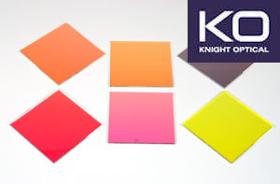- europages
- >
- COMPANIES - SUPPLIERS - SERVICE PROVIDERS
- >
- heat energy
Results for
Heat energy - Import export

KNIGHT OPTICAL (UK) LTD
United Kingdom
Plastic materials may crack under the prolonged exposure to a UV light source… But not Knight Optical’s Dichroic Hot Mirrors! Knight Optical can supply you with high quality and cost effective Dichroic Hot Mirrors for use in optical systems where unwanted UV or IR light negatively impacts on the system quality. This includes UV and IR Sensitive Systems, medical illumination and display fibre optics. Prolonged exposure to UV light can cause degradation in plastic materials resulting in cracking and, eventually, mechanical failure. Exposure to IR can cause undesired thermal energy and heat into the system that can damage delicate components. Dichroic hot mirrors solve this issue by reflecting UV and IR light away from the component, meaning cost We hold a massive inventory of Bandpass, Long pass, Short pass, Band-blocking and Colour-correction filters. For more information Read the PDF...
Request for a quote
VICTORY LIGHTING (UK) LTD.
United Kingdom
Tests of Victory PET lamps against a major competitor show that they provide more heat energy per Watt, so will save money for the user. They also have longer life than many competitors, which reduces replacement cost. They are available in a clear finish for use with external reflectors, or with a reflector coating. This coating focuses infrared heat forward in the direction where it is required, reducing the loss of heat to the rear and improving efficiency.
Request for a quote
COLLOIDE ENGINEERING SYSTEMS
United Kingdom
Colloide designs and builds customised energy centres which generate heat which can then be distributed to buildings or district heat networks. We can also incorporate CHP units within the energy centre, providing electricity along with heat and a low carbon heat and power solution. Our energy centres are often designed to have more than one energy source, allowing the plant operator to vary the energy sources in relation to the energy demand and the best value for money at a given time. The energy sources may include: Gas fired boilers. Biomass boilers. Heat pump. Oil fired boilers. Combined Heat and Power (CHP) unit Our centres are engineered to include the energy sources, thermal stores, instrumentation, control systems, pumping and pipework network – building in as much flexibility as possible so that the plant can be operated as efficiently as possible.
Request for a quote
COLLOIDE ENGINEERING SYSTEMS
United Kingdom
Colloide designs and installs heat pump systems. The heat pump extracts the energy at the source temperature and then raises the temperature to a useable level. A heat exchanger is used to extract the heat from the circuit at this point, with the now cooled medium being returned to the source where it is reheating. Reversible heat pumps can also be used in cooling function which can be important in the summer months. The heat pump works as part of a closed loop, operating between the heat source and the building where it is to be used. Heat sources include air, water, ground and waste heat. The higher the temperature and larger the size of the source energy, the better it is for providing energy. Colloide designs its systems to maximise the return from the heat source. Our heat pumps include a control system. The control system will vary depending on the plant, but is always designed to give our customers full control, including the ability to monitor performance remotely.
Request for a quote
COLLOIDE ENGINEERING SYSTEMS
United Kingdom
District heating systems include a centralised energy centre which then distributes the heat through a network of insulated pipes to the buildings which are connected to the network. The network of pipework consists of a flow and return loop which passes each building. Colloide uses local substations in each building to control the flow of water from the district heating pipework loop through each substation and this flow is used to generate heat in the local building. The central energy centres are generally designed to have more than one energy source, which allows the plant operator to select the most cost efficient and sustainable way of providing the energy needed with the energy sources being brought on and off line to meet demand. We design and build the district heating and cooling networks to include the pumps, pipework, thermal stores, instrumentation, control systems, local substations, heat exchangers and communication through a central control system.
Request for a quoteDo you sell or make similar products?
Sign up to europages and have your products listed
Results for
Heat energy - Import exportNumber of results
5 ProductsCompany type